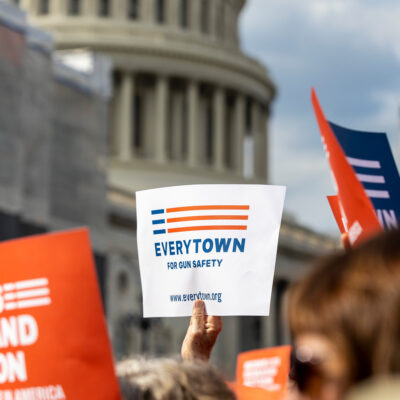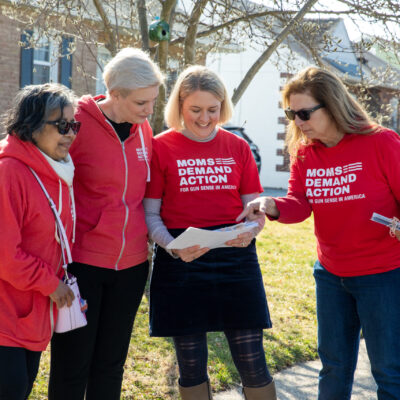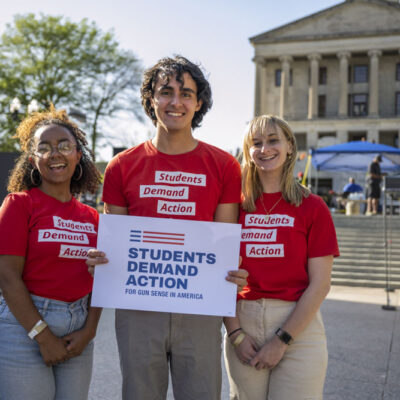NEW REPORT: Everytown for Gun Safety and Johns Hopkins Center for Gun Violence Solutions Release New Guidance for Implementing Extreme Risk Laws to Prevent Gun Violence and Save Lives
5.30.2023
New report provides six specific steps to guide implementation and evaluation of these laws
NEW YORK – Everytown for Gun Safety and the Center for Gun Violence Solutions at the Johns Hopkins Bloomberg School of Public Health released a new set of recommendations for policymakers and practitioners to effectively implement extreme risk protection orders, which are laws that allow for the temporary removal of firearms when an individual is at risk of hurting themselves or others.
The report, “Promising Approaches for Implementing Extreme Risk Laws: A Guide for Practitioners and Policymakers,” was released on May 30, 2023.
Extreme risk protection orders (ERPOs) also known as red flag laws, provide a mechanism to intervene and temporarily remove and prevent the possession of firearms when there are warning signs that an individual poses a risk of harm to self or others. Twenty-one states, and Washington DC, have these laws. Early research shows they are a promising strategy for preventing gun suicide and for intervening in response to credible multiple victim/mass shooting threats.
The report provides guidance for state and local leaders during each step of the petitioning process and ensure they are well positioned to create infrastructure, institute comprehensive training programs, raise awareness, and evaluate their impact.
Among the report’s recommendations:
- State and local infrastructure should coordinate the training and outreach among key groups including law enforcement, prosecutors, city/county attorneys, judges, social services, and health care providers.
- Extreme risk laws should be used alongside other potential crisis intervention tools, including connections to social support systems and appropriate resources when appropriate.
- Clear information about court processes, including directions on how to complete forms, should be made available.
- A comprehensive safety plan should be developed by implementers, including law enforcement, following a court issued extreme risk order to facilitate safe dispossession of firearms and connect the individual whose firearms are removed to social supports as necessary.
- The petition process should be accessible to non-law enforcement petitioners, which may include families, partners, health care providers, school administrators, and coworkers, as specified by state law.
- States and/or localities should conduct regular systematic review of the processes and case outcomes, to ensure transparency and accountability, as well as to identify potential inequities in the implementation of the law.
The recommendations were informed by discussions from representatives across the country where extreme risk laws are being implemented, including researchers, advocates, law enforcement, clinicians, and other organizations, at a convening co-hosted by the Johns Hopkins Center for Gun Violence Solutions and Everytown for Gun Safety in December 2022.
In just the last year, the country witnessed multiple high-profile shootings where ERPOs could have been used, including last November in Colorado Springs and at the University of Virginia, and last May in Buffalo, New York. However, these laws are inconsistently implemented, suggesting a need for more focused efforts to improve implementation. The recommendations in the new report provide such guidance to policymakers and practitioners.
“Extreme risk laws save lives – but only if they are implemented and used. These recommendations provide much-needed guidance for the policymakers and practitioners who are responsible for making sure that this life-saving intervention is accessible and can be effectively used to prevent gun violence,” said Chelsea Parsons, Director of Implementation for Everytown for Gun Safety and co-author of the report. “We have seen too many communities torn apart by tragedies that could have been prevented if an extreme risk protection order had been used and we look forward to working with communities across the country to utilize these recommendations and save lives from gun violence.”
Following the mass shootings in Buffalo, New York and Uvalde, Texas, President Biden signed the Bipartisan Safer Communities Act of 2022, landmark legislation that included $750 million in new federal grant funding over the next five years to support violence prevention programs, including extreme risk protection law implementation.
“For the first time in 30 years, there is dedicated funding available to address the public health crisis of gun violence,” says Lisa Geller, MPH, co-lead of the ERPO Resource Center at the Johns Hopkins Center for Gun Violence Solutions and co-author of the report. “Extreme risk laws are a promising policy to save lives. We are in a critical moment where jurisdictions with these laws can use this new set of recommendations, in conjunction with the federal funding, to support effective implementation.”
Late last year, Everytown for Gun Safety Support Fund established the Everytown Implementation Center, a new effort to provide comprehensive support and guidance to state and local leaders on the effective implementation of life-saving gun laws, including extreme risk laws. The Johns Hopkins Center for Gun Violence Solutions received a grant earlier this year from the Department of Justice, part of the Bipartisan Safer Communities Act funding, to establish an ERPO Resource Center dedicated to providing training and technical assistance in support of these laws. Recommendations from the report will be used to support communities implementing these policies.




